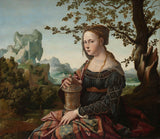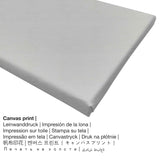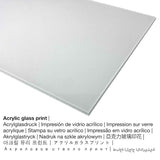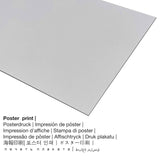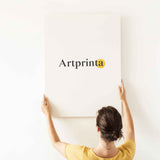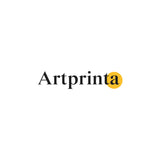Jan van Scorel, 1530 - Mary Magdalene - ọmarịcha nka
Ụtụ gụnyere. Mbupu gbakọrọ na ndenye ọpụpụ.
Mary Magdalene dị ka nka ebipụta
N'afọ 1530, onye na-ese ihe Jan van Scorel created the work of art. It is included in the RijksmuseumNchịkọta nka, nke bụ ụlọ ihe ngosi nka kacha ukwuu maka nka na akụkọ Dutch site na Middle Ages ruo ugbu a. Site n'ikike nke Rijksmuseum (ikike ngalaba ọha).Creditline of the artwork: . What is more, the alignment of the digital reproduction is landscape and has a side ratio of 1.2: 1, nke pụtara na ogologo bụ 20% ogologo karịa obosara. Jan van Scorel was a architect, painter, whose artistic style can be attributed mainly to Northern Renaissance. The Dutch artist lived for a total of 67 afọ - amuru n'ime 1495 in Schoorl, North Holland, Netherlands and passed away in 1562 in Utrecht, Utrecht province, Netherlands.
Nye iwu ngwaahịa ị ga-achọ inwe
The product dropdown menu gives you the possibility to choose your prefered size and material. In order match your personal requirements perfectly, you can choose among the following product customization options:
- Mbipụta enyo acrylic: An acrylic glass print, which is often named as a an art print on plexiglass, transforms your favorite original artwork into gorgeous home décor. The great benefit of a plexiglass fine art print is that contrasts and small color details become more visible because of the very subtle gradation.
- Mbipụta aluminom (aluminium dibbond): Aluminium Dibond prints are metal prints with an impressive effect of depth, creating a modern impression throuch a non-reflective surface structure. For the Aluminium Dibond option, we print your selected work of art right onto the aluminium composite white-primed surface. The bright & white parts of the original artwork shimmer with a silky gloss, however without any glare. The colors are luminous in the highest definition, the fine details of the print appear crisp.
- Mbipụta kwaaji: A UV printed canvas material mounted on a wood stretcher frame. Further, a printed canvas creates a charming and pleasant impression. Hanging your canvas print: The advantage of canvas prints is that they are relatively low in weight, which means that it is easy and straightforward to hang your Canvas print without additional wall-mounts. Hence, a canvas print is suited for all kinds of walls.
- Mbipụta akwụkwọ mmado (ihe kwaaji): Our poster is a printed cotton canvas with a nice texture on the surface. The printed poster is best designed for framing the art print using a custom-made frame. Please note, that depending on the size of the poster we add a white margin of approximately 2-6cm around the artwork to facilitate the framing.
Ederede iwu: We do our best to describe the art products as accurate as possible and to exhibit them visually. However, the tone of the printed materials, as well as the printing may differ slightly from the representation on the monitor. Depending on your screen settings and the condition of the surface, not all colors are printed one hundret percent realistically. Given that all our art reproductions are printed and processed manually, there may as well be slight variations in the motif's exact position and the size.
Nkọwa ngwaahịa ahaziri ahazi
| Nkewa bipụta: | mmepụta nka |
| Mmeputakwa: | dijitalụ mmeputakwa |
| Usoro mmepụta: | Mbipụta UV ozugbo (mbipụta dijitalụ) |
| Mmalite nke ngwaahịa a: | emepụtara na Germany |
| Ụdị ngwaahịa: | mmepụta ihe na-achọ |
| Eji ngwaahịa a chọrọ: | mgbidi mgbidi, ime ụlọ |
| Ndepụta: | usoro odida obodo |
| Oke akụkụ onyonyo: | 1.2: 1 |
| Akụkụ onyonyo pụtara: | ogologo bụ 20% ogologo karịa obosara |
| Akụrụngwa ị nwere ike ịhọrọ site na: | Mpempe akwụkwọ, akwụkwọ mmado (akwụkwọ kwaaji), mbipụta ọla (aluminium dibond), mbipụta iko acrylic (nwere ezigbo mkpuchi iko) |
| Nhọrọ nha nha mbipụta kanvas (akwa akwa na etiti ihe ndọtị): | 60x50cm - 24x20", 120x100cm - 47x39", 180x150cm - 71x59" |
| Mpempe iko acrylic (nwere ezigbo mkpuchi iko) nha: | 60x50cm - 24x20", 120x100cm - 47x39", 180x150cm - 71x59" |
| Mbipụta akwụkwọ mmado (akwụkwọ kwaaji): | 60x50cm - 24x20", 120x100cm - 47x39" |
| Nhọrọ nke mbipụta aluminom (aluminium dibond material) | 60x50cm - 24x20", 120x100cm - 47x39" |
| Nhazi mbipụta nka: | enweghị etiti |
Data ndabere gbasara nka pụrụ iche
| Aha nka: | "Mary Magdalene" |
| Nhazi nka nka: | sere |
| Otu sara mbara: | nka ochie |
| Nhazi oge: | 16th narị afọ |
| Afọ nka: | 1530 |
| Afọ nka: | gbara afọ 490 |
| Ụlọ ihe ngosi nka: | Rijksmuseum |
| Ebe ngosi nka: | Amsterdam, Netherlands |
| Ebe nrụọrụ weebụ ihe ngosi nka: | Rijksmuseum |
| License: | ngalaba ọha |
| Site n'aka: | Rijksmuseum |
Nchịkọta nkenke nke onye na-ese ihe
| Ihe nkiri: | Jan van Scorel |
| Aha ndị ọzọ: | Scorel Jan van, Scorelius Jan van, Schoorl Jan van, Schoorel Jan van, Jan Scorel, Jan Schoorel, Scorel, Jan Schorel, Scoreel Jan van, scorel jan van, j. van scorel, Schorel Jan van, Schoorl, Scorelius, Schoorel, Schoreel Jan van, J. Schoreel, J. Schorel, Van Scorel Jan, Jan van Scorel, Jan van Schoorel, Jean Schooreel, ian scorel, Scharel, J. Schoorel, Schoret, Johann Schorell, Scorellius Jan van, Schorel, Schoorls |
| okike nke onye nka: | nwoke |
| Nationality: | Dutch |
| Ọrụ nke onye na-ese ihe: | onye na-ese ihe, onye na-ese ụkpụrụ ụlọ |
| Mba onye si: | mba netherland |
| nhazi ọkwa: | nna ukwu ochie |
| Ụdị nka: | Northern Renaissance |
| Nwụrụ na afọ nke: | 67 afọ |
| Afọ ọmụmụ: | 1495 |
| Ebe omuma: | Ụlọ akwụkwọ, North Holland, Netherlands |
| Nwụrụ n'afọ: | 1562 |
| Obodo ọnwụ: | Utrecht, mpaghara Utrecht, Netherlands |
Enwere ikike nwebiisinka © | Artprinta (www.artprinta.com)
Ozi nka site na Rijksmuseum (© nwebiisinka - Rijksmuseum - Rijksmuseum)
The woman is Mary Magdalene. She can be identified by her jar of ointment, which she used to anoint Jesus’s feet. Van Scorel painted her as a seductive, luxuriously dressed courtesan, a reference to her reputed past as a prostitute. Her clothing shows the influence of Italian painting, to which Van Scorel was introduced during his trip to Rome.

